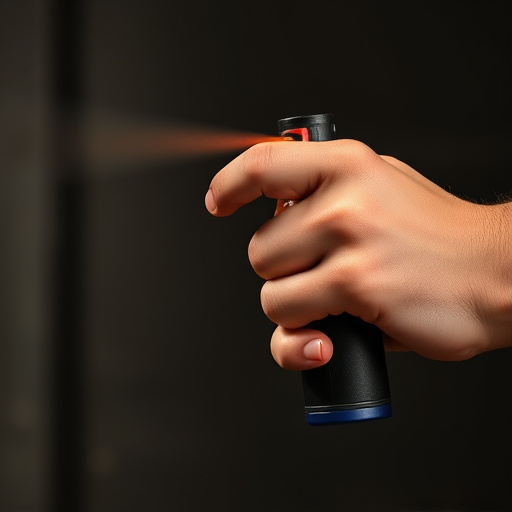Pepper spray, a popular civilian self-defense tool using capsaicin from chili peppers, provides crucial escape time with its quick onset and short duration. Effective range is 2-5 meters. Proper immediate care includes washing eyes and skin with soap and water and moving to fresh air if breathing is affected. While it temporarily incapacitates assailants, pepper spray should be used as a last resort in life-threatening situations. Understanding local laws, responsible handling, proper training, and aftercare are essential for optimal protection and mitigating legal risks. Accidental discharge requires prompt medical attention.
“Defensive spray has emerged as a powerful tool for civilian self-protection, offering an immediate line of defense against potential threats. This article delves into the intricacies of pepper spray, exploring its active ingredients and effectiveness in neutralizing aggressors. We navigate the legal considerations and safety protocols surrounding its civilian use, ensuring responsible deployment. Additionally, we provide essential guidelines on application techniques and post-exposure care to maximize protection and promote swift recovery from pepper spray incidents.”
- Understanding Pepper Spray: Active Ingredients and Effectiveness
- Legal Considerations and Safety Protocols for Civilian Use
- Application Techniques and Aftercare for Optimal Protection
Understanding Pepper Spray: Active Ingredients and Effectiveness
Pepper spray, also known as oleoresin capsicum (OC) spray, is a popular self-defense tool among civilians. Its primary active ingredient is capsaicin, a compound derived from chili peppers that causes a burning sensation when it comes into contact with mucous membranes in the eyes and respiratory system. This irritant disrupts normal cell function, leading to immediate symptoms like tears, coughing, sneezing, difficulty breathing, and temporary blindness—providing users with crucial time to escape potentially dangerous situations.
The effectiveness of pepper spray lies in its rapid onset and short-lived impact. With a range typically between 2-5 meters, it allows users to deploy the spray from a safe distance. The immediate care for pepper spray exposure involves washing eyes and skin with soap and water as soon as possible. If breathing is affected, victims should move to fresh air immediately. It’s important to note that while pepper spray is a powerful deterrent and can incapacitate an assailant temporarily, it does not always guarantee personal safety and should be used as a last resort in life-threatening situations.
Legal Considerations and Safety Protocols for Civilian Use
When considering defensive spray for civilian protection, it’s crucial to understand the legal landscape and safety protocols surrounding its use. Each jurisdiction has specific laws and regulations dictating who can possess and use pepper spray, as well as under what circumstances. Civil liability and potential criminal charges are significant considerations; using force, including pepper spray, must be a last resort and in self-defense or defense of others.
Safety protocols for civilian use emphasize responsible handling and immediate care if exposure occurs. This includes proper training on usage, understanding the range and effects of the spray, and knowing how to administer first aid to affected individuals. In cases of accidental discharge or misuse, seeking immediate medical attention is vital. Knowing local laws and following safety guidelines ensures that defensive spray remains an effective tool for personal protection without causing unintended harm or legal repercussions.
Application Techniques and Aftercare for Optimal Protection
Application Techniques and Aftercare for Optimal Protection
When using a defensive spray, proper application techniques are key to ensuring its effectiveness. Aiming correctly is crucial; hold the can at arm’s length, point it towards the attacker’s face, and pull the trigger in a steady motion. It’s important to note that a good defensive spray should create a cloud of spray, covering the attacker’s eyes, nose, and mouth. Practice makes perfect, so familiarizing yourself with the spray’s range and distribution can significantly improve your response time and accuracy.
After immediate care for pepper spray involves several steps. First, move to a safe distance from the attacker and wash your face with cold water for at least 15 minutes to dilute the chemical irritant. Avoid rubbing your eyes or nose as it might worsen irritation. Next, change into clean clothes, preferably ones you can discard or launder immediately. If possible, seek medical attention, especially if symptoms persist or severe reactions occur. Proper aftercare ensures minimal discomfort and promotes quicker recovery, allowing you to focus on staying safe.
Defensive spray is a powerful tool for civilian protection, offering immediate care in dangerous situations. By understanding the active ingredients, legal considerations, and application techniques, individuals can maximize its effectiveness while adhering to safety protocols. Remember, proper aftercare is crucial, ensuring the best possible outcome when faced with a sudden attack. With knowledge and responsible usage, pepper spray can be a game-changer for personal safety in today’s world.
